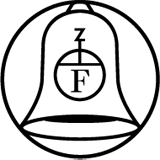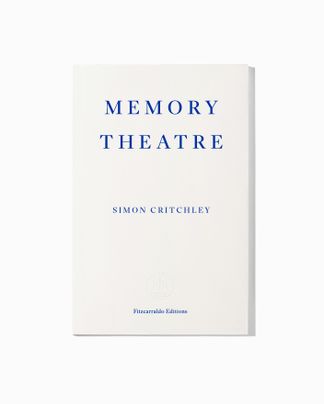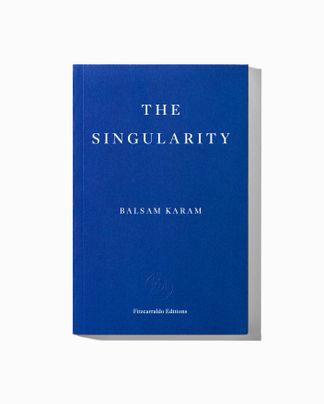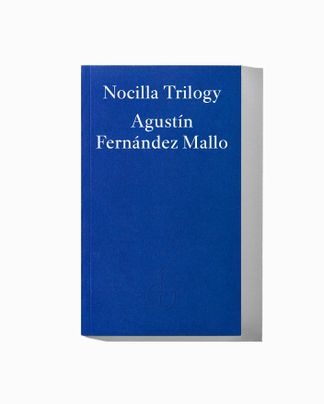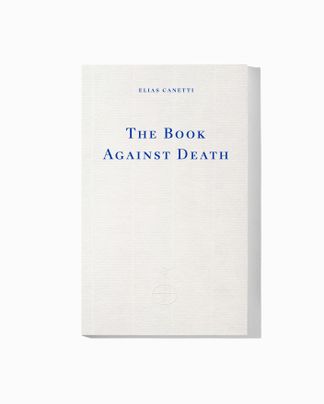In his foreword to The Ways of Paradise, Peter Cornell presents this so-called found manuscript, the work of a now-deceased, obscure researcher who spent three decades in the National Library of Sweden working on his magnum opus. Upon his death, no trace of this work remains aside from this set of notes and fragments which form an enigmatic set of texts on the connections between art, literature, spirituality and the occult through history, with a particular focus on spirals and labyrinths. Ranging from the Crusades to Ruskin, Freud to surrealism, cubism, automatic writing, Duchamp, the Manhattan Project, Pollock and Smithson, this cult book, first published in Sweden in 1987, is translated into English for the first time by Saskia Vogel.
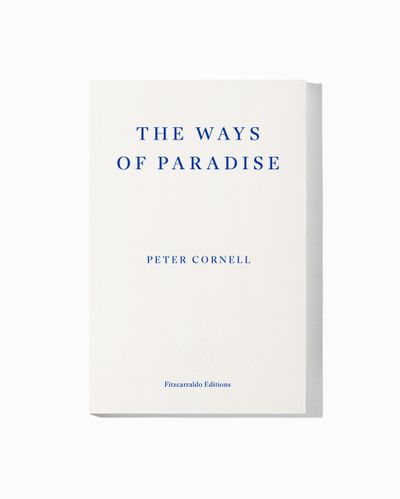
The Ways of Paradise
Translated by Saskia Vogel
French paperback with flaps, 152 pages
Published 21 November 2024
The Ways of Paradise
Translated by Saskia Vogel
Preface
The author of this text was a familiar figure at the National Library of Sweden in Stockholm’s Humlegården. Almost every day for more than three decades he could be spotted in the serene reading room, absorbed in his studies, in reverie. It was said that he was occupied with an uncommonly comprehensive project, a work that – as he once disclosed in confidence – would reveal a chain of connections until then overlooked.
However, even after the thorough investigations following his death, the work in question has yet to be located. Among his effects is a sheaf of papers on which is written ‘The Ways of Paradise: Notes’, which is to say, all that seems to remain of his great work is its critical apparatus.
The found manuscript is type-written on white A4 paper. It consists of 122 loose sheets, collected in said sheaf. Neither the pages nor the notes are numbered. In this edition I have, however, numbered the notes following their order in the manuscript. The extent to which this order was finalized we cannot be sure; other combinations cannot be ruled out. Nor can we be sure that this manuscript contains the complete critical apparatus to The Ways of Paradise, or if this represents but a small part. Certain graphic figures were included in the manuscript; other illustrations, notably reproductions of various artworks named in the text, I have appended myself.
As the author’s sole remaining friend and student, all that is left for me to do is to publish these notes, in the hope that they will provide a glimpse of the lost work’s contours.
Stockholm, June 1987, Peter Cornell
I.
Various types of fantastical tales, ‘contes fantastiques autour des contes originaires’. Jurgis Baltrušaitis, La quête d’Isis: Essai sur la légende d’un mythe, 1985.
2. Ibid.
3. ‘The centre of the world’, ‘the heart of the world.’ This concept recurs in all cultures even as their geographic and topographical situations may vary: country, cave, mountain, tower, temple or city. These imagined places arise from fantasies of a holy land, described as follows by René Guénon: ‘This “holy land”, above all others, it is the finest of lands per the meaning of the Sanskrit word Paradesha, which among the Chaldeans took the form of Pardes and Paradise in the Western world; in other words it refers to the “earthly paradise” that constitutes the point of departure in each religious tradition.’ Here was the origin, here was spoken the first, creative Word. See ‘Les gardiens de la Terre sainte’ (1929), in Symboles fondamentaux de la Science sacrée, 1962.
4. Possibly in André Breton’s object Souvenir du paradis terrestre from 1953, a rugged rock, 11.5 x 9.5 x 5 cm, its title inscribed into the rock.
5. ‘Paradise’, from Old Persian pairidaeza, meaning ‘enclosed garden, park’.
6. On parks as places ‘where the city dwellers’ wild dreams stir’, see Louis Aragon, Le paysan de Paris, 1926.
7. Observe that he ‘imagines himself [sic!] to know’.
8. Cf. here Prof. Gianfranco Ravasi, for whom the term centre – ‘paradise’, ‘cosmic navel’ – is fundamental to descriptions of Jerusalem. The term can be read metaphorically, as a protective circle, a place of refuge, a hortus conclusus. La Gerusalemme celeste, 1983.
9. It was thought that mankind was created in the centre of the world, in the navel of the earth, omphalos. Mircea Eliade has recounted several such myths, among them Mesopotamian and Jewish. Of course, paradise, where Adam was created from dust, lay at the centre of the cosmos. And according to one Syrian tradition Adam was created in the very place where Jesus’s cross was to be raised. The same notion has been preserved in Judaism, where Midrash, one of the oldest methods of biblical exegesis, identifies Jerusalem as the site of Adam’s creation. Adam was buried in the very spot of his creation, at the centre of the world, on Golgotha. Cf. Mircea Eliade, Le Mythe de l’éternel retour, 1949.
10. Regarding Melchizedek as ‘king of the world’, ruler of Salem and the midpoint of the world, see René Guénon, Le Roi du monde, 1958 as well as Heb 7.
11. It can, by the way, be noted that within Jerusalem there are two places and – under the caliph Abd-al-Malik – three religions that could lay claim to the absolute centre of the world. On the one hand, there is the rock that provided the foundation for Solomon’s Temple, the very crown of which marked the altar of burnt offerings; the same rock that was identified as the place of Mohammed’s ascent to heaven. On the other hand, there is the hill Golgotha with the Holy Sepulchre, where the centre of the world is still marked with a bowl containing a round rock. See Lars-Ivar Ringbom, Graltempel und Paradies, Royal Swedish Academy of Letters, History and Antiquities, 1951.
12. The same rock is mentioned in Fredrika Bremer’s travel notes from Palestine: ‘Here they [the pilgrims] kiss a great round marble ball, which they called the “Navel Rock” and is understood to lie in the centre of the earth.’ But the place – the Church of the Holy Sepulchre – otherwise instils in her noteworthy disappointment, ‘a childish spectacle of a tasteless and false character. Devotion or edification thou wilt not perceive in it… My own celebration of Passover was above all interior.’ Lifvet i gamla verlden. Dagboksanteckningar under resor i söder-och österland (Life in the Old World: Diary Entries from Travels in Southern and Eastern Lands), part III, 1861.
(…)
‘An underground classic…. The text is structured in a series of numbered fragments, reflecting a larger fixation on spirals and mazes of all kinds – the curl of a seashell, mimicking the Camino de Santiago pilgrimage’s focus on eternity, or the “ephemeral labyrinthine traces made by the folds and creases of garments” – and drawing parallels among a swath of disciplines and time periods…. [Cornell’s] slow deluge of intertwined facts and stories makes it hard to stop reading. Imagine this as the holy book of a new cult devoted to the spiritual possibilities of the spiral.’
— Rhian Sasseen, The Atlantic
‘The imaginary manuscript is (probably?) about Surrealism, but the notes themselves range widely, offering disquisitions on subjects as far-flung as the 1099 siege of Jerusalem, the geography of Paris and the Rosenberg trial. Some are straightforward, while others are beguilingly ambiguous…. This might make the book sound dry, but Peter Cornell’s meticulous tone, translated into pitch-perfect faux-academic English by Berlinerin Saskia Vogel, is part of a grand Surrealist tradition. He’s having fun collaging text, image and reference, and the frustration of not being able to figure it out turns out to be fun for us too – a trip into a labyrinth with something not-quite-visible at its centre.’
— The Berliner
‘Published in 1987 but arriving in an English translation by Saskia Vogel just in time for our paranoid psychosphere of 2025, The Ways of Paradise oscillates between deduction and seduction in inspiring a kind of conspiratorial reason in the reader…. Reading The Ways of Paradise is like unfolding an interpretation of a dream – or nightmare – we did not ourselves have or no longer remember. As the fragments accrete in spiral form, with names, figures, themes, and shapes recurring, some patchwork sense flits tantalizingly into and out of view.’
— Joseph Albernaz, Brooklyn Rail
‘Like a collision between the fantastical libraries of Borges, David Markson’s art obsessed micronarratives and Iain Sinclair’s occult strain of psychogeography. The Ways of Paradise is a labyrinth I never wanted to escape.’
— Chris Power, author of A Lonely Man
‘Who could have imagined that a set of imaginary orphaned footnotes could yield so much pleasure and fascination? More than a study of the labyrinth motif, The Ways of Paradise is itself a labyrinth, an apparently slim volume pulsing with infinite, overlapping worlds, an intricate meditation on the abysses of reality and illusion.’
— Josh Cohen, author of How to Live. What to Do.: In search of ourselves in life and literature
‘The Ways of Paradise is the story of a lost manuscript and the labyrinth of enigmas through which its obscure author wandered, a book that pleasurably situates the reader at the centre of the idea of fiction, a place of everything and nothing from which ever-widening circles of mystery and meaning spread out.’
— David Hayden, author of Darker With the Lights On
‘Just as any person tracking a spiral or walking a labyrinth will find their sense of space and time collapsed, viewing moments in the past and future of their journey from vividly altered perspectives as they make their way, so the reader of this remarkable ‘manuscript’ will be similarly enlightened. Open, allusive, constantly expanding its appreciation of the covert relations between culture and history, place and belief, The Ways of Paradise embodies its own utopian premise. Assembled with a lightness of touch and a precision in detail, profound in its accumulative insights, it understands that any book aspiring to the fullest incarnation of its potential remains in process more than it offers an arrival. No longer are fragments deployed only formally; rather they serve as waymarkers on a quest passage to the interior, the final labyrinth of human imagination, and the mind’s own mysterious corridors. The spaces between entries are where the doors to this charged site lie. Each traveller will find their own entrance, and each will surely be entranced.’
— Gareth Evans
‘In The Ways of Paradise, notes on a vanished text become clues into a mystery: if the world has a centre, what is located there? Traversing holy cities, land art and myths of eternal return, Peter Cornell leads us into a maze of profound depth, unlocked at last in Saskia Vogel’s exquisite translation.’
— Anna Della Subin, author of Accidental Gods
‘The Ways of Paradise is a work of art, an end in itself, a rich and enigmatic book.’
— Kristoffer Leandoer, Aftonbladet
‘The subjects are woven together in a way that is as intelligent as it is imaginative. Cornell’s book is proof of the author’s erudition ripened into wisdom. Cornell’s labyrinth lives and will live as long as there are readers.’
— Crispin Ahström, Göteborgs-Posten
‘With The Ways of Paradise, Swedish literature has been given something rare … in the fragmentary, anti-historical tradition that was Walter Benjamin’s.’
— Mikael Löfgren, Expressen
‘A stimulating and incredibly elegant anti-essay.’
— Jan Söderqvist, Svenska Dagbladet
‘Here is an author who has immediately taken a leading place among those who work with the non-linear style of writing that already has authorities such as Cortázar, Stanisław Lem and Borges.’
— Ivan Gorev, Literaturnaya Gazeta
Born in Stockholm in 1942, Peter Cornell was a writer, historian and art critic. He taught theory and history of modern art at the University of Arts, Crafts and Design (Konstfack) and the Royal Institute of the Arts (Kungliga Konsthögskolan) in Stockholm, and is an honourary member of the Royal Swedish Academy of Fine Arts (Konstakademien).
Saskia Vogel is the author of Permission (2019), the translator of over twenty Swedish-language books and the deputy editor of the Erotic Review. Her work has been awarded the Berlin Senate grant for non-German literature and the Bernard Shaw Prize. Born and raised in Los Angeles, she now lives in Berlin.
